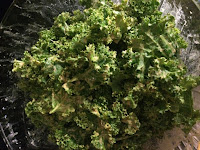I've baked bread before with moderate success - mainly when I made hearty soups. We don't normally eat a ton of bread so I was a bit apprehensive as to how we would eat all of our homemade bread before it started going bad, but I wanted to give it a try.
My first starter turned out to be a dud. It got bubbly and sour smelling, but I ended up adding too much water and had a layer of water on top, which inhibited the yeast culture from growing. When I tried to make a loaf of bread out of that batch, I ended up with a heavy, flour brick.
Then, I tried The Kitchn's sourdough starter recipe. This one worked for me! I found that it was really important to use a scale in measuring out your water to flour ratio. I think using the measuring cups in my first attempt to sourdough starter led to my starter having too much water.
 |
| My Sourdough Starter |
- I ended up having to modify the proportions here and there by minute amounts. I think because of the humidity and relative warmth of our apartment, I ended up with a thin layer of water on top after one or two feedings so I decreased the amount of water by about .1-.25 oz by weight and that worked well.
- The starter also started to smell a little bit like beer. After some googling, I found that the odor meant my starter went too long between feedings so I made sure to stick to my feeding schedule.
My starter is still young so I'm having to use 1.5 teaspoons of commercial yeast to make my sourdough loaves using The Kitchn's Starter Sourdough Recipe. I've read that it takes about 20 feedings to get a good strong starter. I'm getting there, because my starter is starting to grow manyfold in volume.
 |
| My hand-kneaded dough |
We've been hand-kneading the bread and it took 30+ minutes with only moderate success. The loaves turned out delicious, but as you can see in the picture to the right, didn't hold their shapes well. When they rose, they expanded to the size of the bowl they were in.
This past weekend, I grabbed my parents' Kitchen Aid Stand Mixer and used it to knead my bread. It worked so well and was so much easier. I'm so glad I'm able to use theirs and not have to buy my own. I also bought a pizza stone so we could bake round loaves. The first time I used it, I didn't spray it with oil because I thought the coating was nonstick, but we ended up having to saw off the bottom of the loaf because it was stuck on it. This week, I tried the pizza stone again and sprayed it with oil to great success.
My fears in not finishing our bread each week were a bit unnecessary. The loaves are so delicious, we have no problem eating a loaf a week. Each week I make two loaves, but I usually give away the second. Last week we finished our loaf by Thursday and had to go days without bread.
 |
| The KitchenAid kneaded bread |
 |
| This week's loaves! |




